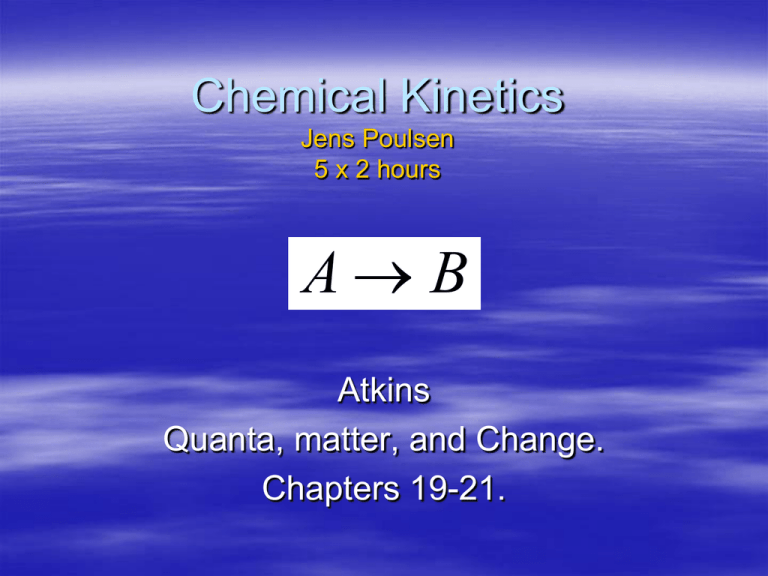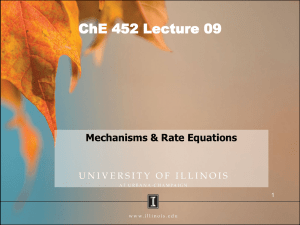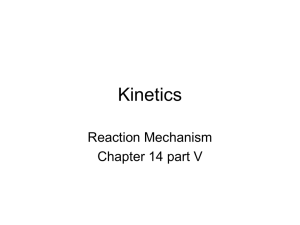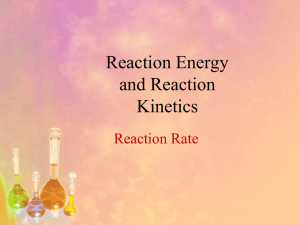Chemical Kinetics Jens Poulsen
advertisement

Chemical Kinetics Jens Poulsen 5 x 2 hours A B Atkins Quanta, matter, and Change. Chapters 19-21. A reaction may be investigated on several levels… stochiometry: 2 N2O5 ( g ) 4 NO2 ( g ) O2 ( g ) rate law: v k [ N 2O5 ( g )] atomistic: N 2O5 NO2 NO3 k a NO2 NO3 N 2O5 k a ' NO2 NO3 NO2 NO O2 kb NO N 2O5 NO2 NO2 NO2 k c Chapter 22: Rates of chemical reactions. Concepts: Defining reaction rates. Integrated rate laws. Elementary reactions. Consecutive reactions. A B v d [ A] dt k [ A] [ A] [ A]0 exp(kt) A B C A BC Start with chemical kinetics on an empirical level: 2N2O5 ( g ) 4NO2 ( g ) O2 ( g ) Rate equations: How much N2O5 (g) as a function of time etc? No information about reaction mechanism (on an atomic scale). Experimental techniques concentrations can be followed by... Measuring pressure during chemical reaction: 2 N2O5 ( g ) 4 NO2 ( g ) O2 ( g ) Measuring conductivity during chemical reaction: (CH 3 )3 CCl (aq) H 2O(l ) (CH 3 )3 COH (aq) H (aq) Cl (aq) Example 19.1 monitoring variation in pressure. 2N2O5 ( g ) 4NO2 ( g ) O2 ( g ) : fractionof N2O5 thathas decomposed. Amount: N 2O5 NO2 O2 tot la 1 3 n(1 ) 2n n n(1 ) 2 2 3 p p0 n(1 ) 2 Def. of v - rate of reaction 2HOIO(aq) IO3 (aq) H (aq) HOI(aq) v 1 d[ HOIO] 2 dt d[ IO3 ] dt d[ H ] dt d[ HOI ] dt more generally aA bB cC dD 1 d[ A] 1 d[ B] 1 d[C ] 1 d [ D] v (a) dt (b) dt c dt d dt Reaction order A B .. C ... Often has reaction rate of form v k [ A] [ B] ... m n Order m with respect to A,.. Overall order is m+n+.. Examples first order reaction C2 H6 ( g ) 2CH3 ( g ) v k[C2 H6 ( g )] T 7000 C second order reaction 2NOBr( g ) 2NO( g ) Br2 ( g ) v k[ NOBr( g )] 2 zero order reaction N2 3H 2 on Iron 2NH3 ( g ) v k Determination of rate law A B .. C ... v k [ A]m[ B]n ... isolation method: excess of B, C, … m can be determined etc. method of initial rates: vary the conc. of A, B, C, .. In turn and check how rate changes. Integrated rate laws First order rate v d [ A] dt k [ A] [ A] [ A]0 exp(kt) ln([A] /[ A] ) kt straight line: Second order rate 0 v d [ A] dt k [ A] straight line: 2 1 1 [ A] [ A]0 kt 1 [ A]1 [ A]0 kt v d [ A] dt k [ A][B] leads to [ B] /[ B]0 ln( ) kt ([B]0 [ A]0 ) [ A] /[ A]0 Reactions approaching equil. A B BA v k[ A] v k ' [ B] d [ A] k[ A] k '[ B] dt Solution: k ' k exp( (k k ' )t ) k ' k for t : [ A]eq [ A]0 k' k ' k [ A] [ A]0 [ B]eq [ A]0 [ A]eq [ A]0 K [ B]eq [ A]eq [ B]0 0. k k ' k k k' Relation between equilibrium constant and rate constants. Disturbing a system in eq: k A B k' Sudden change in k , k ' e.g. by change in T. [ A] [ A]eq x [ B] [ B]eq x d [ A] k[ A] k '[ B ] k ([ A]eq x) k ' ([B]eq x) dt d [ A] d [ A] dx kx k ' x but dt dt dt dx (k k ' ) x x(t) x(0)exp(-( k k ' )t ) dt The rate to new equilibrium is given by the sum of k, k' 1 k k' Example 19.4 k' H 2O(l ) H (aq) OH (aq) KW [ H ][OH ] / c k 37s 3710 s. 6 Calculate the rate constants k, k' for water autoprotolysis, given Forward/backward reaction is first/secondorder, respectively, and T=298 K, pH=7. BLACK-BOARD! 2 Temperature dependence of chemical reactions. A B C v k (T )[ A][B] What can be said about k(T) ? k (T ) A exp(Ea / RT ) Arrhenius equation Svante Arrhenius Nobel prize 1903. interpretation k (T ) A exp(Ea / RT ) A B C v k (T )[ A][B] *Reaction coordinate: molecular distortion along which the reactants become products. *Transition state = activated complex = climax of reaction. *Once the reactants have passed the transition state, products are formed. interpretation k (T ) A exp(Ea / RT ) Ea: activation energy (change in potential energy). Only molecules having kinetic energy larger than Ea get over barrier. exp(-Ea/RT): fraction of reactants having enough kinetic energy to pass barrier A: pre-exponential factor: measure of the rate of collisions k (T ) A exp(Ea / RT ) A B C v k (T )[ A][B] exp(-Ea/RT): fraction of reactants having kinetic energy higher than barrier height Ea. A: proportional to collision frequency. K(T) = collision frequency times fraction of successful collisions = A * exp(-Ea/RT) Accounting for the rate laws. Elementary reactions: The fundamental “building blocks” of chemical reactions. Describes what happens on an atomic scale. CH 3 I CH 3CH 2O CH 3OCH2CH 3 I one ethanoate ion collides with one methyliodide molecule and forms one iodide ion plus one methylethylether…. Elementary reactions The molecularity of a reaction: # of molecules participating. Unimolecular: one molecule. Bimolecular: two molecules. A unimolecular reaction is first-order. A bimolecular reaction is second-order. AP d[ A] / dt k[ A] A B P d [ A] / dt k[ A][B] Elementary reactions If we know a reaction is single-step and bimolecular we can write down a rate equation directly: A B P d[ A] / dt k[ A][B] Same applies to unimolecular reactions... Elementary reactions On the other hand, consider the reaction A( g ) B( g ) P( g ) A rate law of form d[ A] / dt k[ A][B] does not imply the reaction to be simple bimolecular: A B P Example. v k[ HBr( g )][O2 ( g )] Consecutive elementary reactions ka kb A I P example: enzyme/substrate Solving time-dependence of [P]. ka kb A I P BLACK-BOARD! ka exp(kbt ) kb exp(ka t ) [ A]0 [ P] 1 kb k a Consecutive reactions Qualitative time-dependence of [A], [I] and [P]. Steady State approx. VERY IMPORTANT!! The higher the molecularity, the more complex mathematics when solving rate equations. Need approximation. Introduce steady state approximation: ka kb A I P [I ] 0 d[I ] 0 dt kb k a Steady state approx. continued. More generally: all intermediates I , I ,...,I are assumed to have negligible concentration and rate of change of concentration: 1 [ I1 ] 0,[ I 2 ] 0,...,[ I n ] 0 d[ I n ] d [ I1 ] d[I 2 ] 0, 0,....., 0 dt dt dt 2 n Apply steady state approx. to consecutive reaction. ka kb A I P d[I ] k a [ A] kb [ I ] 0 [ I ] k a [ A] / kb dt d [ P] kb [ I ] k a [ A] k a exp( k a t )[ A]0 dt d [ P] kb [ I ] k a [ A] k a exp(k a t )[ A]0 dt [ P] [ P ]0 s d [ P] dtk a exp(k a t )[ A]0 0 [ P] [ P]0 (1 exp(k a t ))[A]0 [ P] (1 exp(k a t ))[A]0 Steady state example. 2 N2O5 ( g ) 4 NO2 ( g ) O2 ( g ) N 2O5 NO2 NO3 k a NO2 NO3 N 2O5 k a ' NO2 NO3 NO2 NO O2 kb NO N 2O5 NO2 NO2 NO2 k c Two intermediates: NO and NO3. d [ NO3 ] / dt 0 0 k a [ N 2O5 ] (k a' kb )[NO2 ][NO3 ] d [ NO] / dt 0 0 kb [ NO2 ][NO3 ] kc [ NO ][N 2O5 ] d [ N 2O5 ] / dt ka [ N 2O5 ] ka' [ NO2 ][NO3 ] kc [ NO][N 2O5 ] Hence..[exercise]: d[ N2O5 ] / dt 2ka kb [ N2O5 ] /(k kb ) ' a Rate determining step Example. when ka<kb then ka kb A I P may be treated as a simple reaction: ka A P ”the principle of the rate determining step” Proof: When ka<kb then ka exp(kbt ) kb exp(ka t ) [ A]0 [ P] 1 kb k a becomes [ P] 1 exp(ka t ) [ A]0 [ A]0 [ A]t as expected Rate determining step – in general If one elementary step in a reaction is slower than others then this step controls the rate of the overall reaction. The slow step is rate determining if it can’t be sidestepped. Once the rate determining step is found, the rate expression can be written down immediately. Example. ka kb ka ' kb ' A I P A I ' P Even if ka<< kb the upper reaction may be sidestepped if ka<ka’ and ka<kb’. Then ka A I is not rate determining. Preequilibria. ka kb A B I P ka ' Assume A and B are in eq. then ka [I ] K K ' [ A][B] ka d[ P] / dt kb [ I ] kb K [ A][B] Example. Analysing pre-eq. by steady state. we do not assume eq. ka kb A B I P ka ' d [ P] / dt kb [ I ] d [ I ] / dt kb [ I ] k a [ A][B] k a' [ I ] 0 k a [ A][B] k a kb [ A][B] [I ] d [ P] / dt ' kb k a kb k a' When pre-eq exists kb<ka’ ka kb A B I P ka ' ka kb [ A][B] ka kb [ A][B] d [ P] / dt ' kb k a ka' theold pre- eq analysisresult. Unimolecular reactions. Lindemann Hinshelwood mechanism. cyclo C3 H 6 CH 3CH CH 2 v k[cyclo C3 H 6 ] Found to involve bimolecular step, how can it be first order? The reaction is not given by an elementary first order mechanism. Can be described by the Lindemann Hinshelwood mechanism. Lindemann Hinshelwood d [ A ] ka [ A]2 dt ka A A A A d [ A ] A A A A ka ' [ A][ A ] dt ka ' kb A P d[ A ] kb [ A ] dt Use steady state... d [ A ] kb [ A ] ka ' [ A][ A ] ka [ A]2 0 dt ka [ A]2 [A ] kb ka ' [ A] 2 k k [ A ] d [ P] d [ P ] kb [ A ] 0 b a dt dt kb ka ' [ A] If kb is small: kb << ka’ [A] then firstorder reaction d [ P] kb k a [ A] dt ka ' On the other hand at low pressure: d [ P] k a [ A]2 dt Since the reaction ka A A A A d [ A ] ka [ A]2 dt becomes ”bottleneck”. Define effective rate constant: k k [ A] d [ P] kb ka [ A]2 b a [ A] K [ A] dt kb ka ' [ A] kb ka ' [ A] with K kb ka [ A] kb ka ' [ A] Lindemann Hinshelwood mechanism gives linear plot K 1 ka ' d [ P] 1 1 [ A] / [ A] dt ka k a kb The kinetics of complex reactions Chain reactions Explosions Catalysis (enzymes) What is a chain reaction? Example, thermal decomposition of ethanal: CH 3CHO( g ) CH 4 ( g ) CO( g ) Elementary reactions (Rice-Herzfeld): initiation: CH 3CHO CH 3 CHO v ki [CH 3CHO] propagation : CH 3 CH 3CHO CH 4 CH 3CO v k p [CH 3 ][CH 3CHO] propagation : CH 3CO CO CH 3 v k ' p [CH 3CO] termination : 2CH 3 CH 3CH 3 Chain carriers are CH3 and CH3CO radicals v kt [CH 3 ]2 Derivation of rate law: Steady state: d [CH 3 ] ki [CH 3CHO] k p [CH 3 ][CH 3CHO] dt k p' [CH 3CO] kt [CH 3 ]2 0 d [CH 3CO] k p [CH 3 ][CH 3CHO] k p' [CH 3CO] 0 dt Add these together: ki 0 ki [CH 3CHO] kt [CH 3 ] [CH 3 ] [CH 3CHO] kt 2 Insert into 0 ki [CH 3CHO] kt [CH 3 ] [CH 3 ] 2 ki [CH 3CHO] kt d [CH 4 ] k p [CH 3 ][CH 3COH ] dt ki kp [CH 3COH ]3 / 2 kt As observed experimentally. Key elements of chain reaction Initiation: involves formation of chain carriers propagation: done by chain carriers Termination: chain carriers are ”destroyed”. New example: Br2 ( g ) H 2 ( g ) 2HBr( g ) Initiated by heat. New example: Br2 ( g ) H 2 ( g ) 2HBr( g ) Complicated rate law: d [ HBr] k[ H 2 ][Br2 ]3 / 2 dt [ Br2 ] k '[ HBr] Can be explained by postulating a chain reaction mechanism. Mechanism: collision induced Initiation: Br2 M 2 Br M Propagation : Br H 2 HBr H v k p [ Br][H 2 ] Propagation : H Br2 HBr Br v k ' p [ H ][Br2 ] Retardation : H HBr H 2 Br v k r [ H ][HBr] T ermination : Br Br Br2 v kt [ Br]2 Retardation step: A product is removed. Chain carriers are H and Br radicals. Steady state analysis. Rate of formation d [ HBr ] k p [ H 2 ][ Br ] k p '[ H ][ Br2 ] k r [ HBr ][ H ] dt Steady-state: d [ H ] k p [ H 2 ][Br] k p '[ H ][Br2 ] k r [ HBr][H ] 0 dt d [ Br] 2ki [ Br2 ][M ] k p [ H 2 ][Br] k p '[ H ][Br2 ] k r [ HBr][H ] dt 2kt [ Br]2 [ M ] 0 Adding these two equations give 2ki [ Br2 ][M ] 2kt [ Br] [ M ] 0 [ Br] 2 ki [ Br2 ]1/ 2 kt Inserting the expression for Br radical into first eq. gives ki kp [ Br2 ]1/ 2 [ H 2 ] kt [ H ] k ' p [ Br2 ] k r [ HBr] Substituting into rate expression gives d [ HBr] k p [ H 2 ][Br] k p '[ H ][Br2 ] k r [ HBr][H ] dt ki 2k p [ H 2 ][Br2 ]3 / 2 kt [ Br2 ] (k r / k ' p )[HBr] Which has the same form as the experimental rate law provided k 2k p ki kt k ' (k r / k ' p ) Explosions An explosion is a rapidly accellerating reaction arising from a rapid increase in reaction rate with increasing temperature fast reactionreleasingheat (exothermi c) T rises even faster reaction T rises even more .. Example O2 ( g ) 2H 2 ( g ) 2H 2O( g ) Has not been fully understod. # Chain carriers grow exponentially. initiation: H 2 H H v const vinit propagation : H 2 OH H H 2O v k p [ H 2 ][OH ] branching: O2 H O HO v kb [O2 ][H ] O H 2 H HO v k 'b [O][H 2 ] 1 termination : H wall H 2 v kt [ H ] 2 H O2 M HO2 M v kt '[ H ] H , OH , O chain carriers are Branching: one chain carrier becomes two or more. Occurence of explosion given by explosion region (regions of T,p). If T is low, rate constants are too small. If p is low, the reaction rates, v, are too low due to infrequent collisions. Example Show that an explosion happens when rate of chain branching exceeds that of chain termination. Answer: Focus only on the rate of prod of H chain carrier as important. Rate of change of chain carrier: d [ H ] vini k p [ H 2 ][HO] kb [ H ][O2 ] dt kb '[O][H 2 ] kt [ H ] k 't [ H ][M ][O2 ] Example Steady state approximation: d [OH ] k p [OH ][H 2 ] kb [O2 ][H ] k 'b [O][H 2 ] 0 dt d [O] kb [O2 ][H ] k 'b [O][H 2 ] 0 dt k [OH ] 2 b [O2 ][H ] /[ H 2 ] kp [O] kb [O2 ][H ] / k 'b [ H 2 ] Then chain carrier production rate is d [ H ] vini ( 2kb [O2 ] kt k 't [ M ][ O2 ])[ H ] dt Example write: kbranch 2kb [O2 ] measuringchain branchingrate. kterm kt kt' [O2 ][M ] measuringterminati on rate. Then chain carrier production rate is d [ H ] vini ( kbranch kterm )[ H ] dt vinit a) [ H ] (1 e ( kterm kbranch ) t ) kbranch kterm kterm kbranch vinit b) [ H ] (e ( kbranch kterm ) t 1) kbranch kterm kbranch kterm Homogeneous catalysis A catalyst lowers the activation energy for a reaction. It is not consumed in the reaction (reforms in the end). Examples are enzymes, metal catalysts etc. Homogeneous catalysis: the catalyst exists in same phase as reactants. Example: 2H 2O2 (aq) 2H 2O(l ) O2 ( g ) as catalyzed by bromide ions. 2 H 3O H 2O H 2O H 3O2 2 K [ H 3O2 ] /[ H 3O ][H 2O2 ] 2 H 3O Br HOBr H 2O v k[ H 3O ][Br ] HOBr H 2O2 H 3O O2 Br ( fast) Notice that bromide reappears in the end. Enzymes Enzymes (E) are biological catalysts. Typical proteins. Contains an active site that binds substrate (S): Induced fit model: S induces change in E and only then do they fit together. E S ES P E Michaelis Menten mechanism. Three exp. observations i) For a given amount of S, the rate of product formation is proportional to [E]. ii) For a give amount of E and low values of [S], the rate of product formation is proportional to [S]. iii) For a given amont of E and high values of [S], the rate of product formation reaches a max. value, v(max), and becomes independent of [S]. i) and ii) - but not iii) - is consistent with E S P E v k[S ][E] Michaelis-Menten explains i)-iii) E S ES k a , k 'a ES P E kb leads to kb [ E ]0 v kb [ ES] 1 K M /[S ]0 [ E ][S ] KM [ ES] Proof. Steady state approx.: then Define [ ES] KM d [ ES ] k a [ E ][ S ] k 'a [ ES ] kb [ ES ] 0 dt ka [ E ][S ] k ' a kb k 'a kb [ E ][S ] ka [ ES ] Use [ E]0 [ E] [ ES] [S ] [S ]0 substratein excess [ E]0 [ ES](1 KM /[S ]) [ ES](1 KM /[S ]0 ) then [ ES] [ E]0 /(1 K M /[S ]0 ) v kb [ ES] kb [ E]0 /(1 KM /[S ]0 ) Then i)-iii) is correct. show! Alternative formula: vmax v kb [ ES] 1 K M /[S ]0 vmax kb [E]0 1 1 1 KM v vmax [ S ]0 vmax Plot of 1/v against 1/[S] gives straight line for MM mechanism. Plot is called Lineweaver-Burk plot Determine enzyme parameters. Lineweaver-Burke plot gives vmax kb [E]0 and K m / vmax v kb [ ES] 1 1 1 KM v vmax [ S ]0 vmax From knowing total enzyme concentration we calc. K m , kb Cannot determine ka , vmax 1 K M /[S ]0 k 'a Catalytic constant. kb gives the number of ”turn overs” pr. unit time. This number – with units of pr time – is called the catalytic constant, k cat E S ES ES P E k a , k 'a kb Catalytic efficiency. E S ES ES P E k a , k 'a kb Catalytic efficiency: measure of overall enzym efficiency equals effective rate constant for overall reaction ka kb v [ES] kb [ E ][S ] kb [ E ][S ] k 'a kb KM kb KM If enzyme is very efficient then kb is large. Then k a , k 'a ES P E kb E S ES ka kb k a k ' a kb ka is determined by diffusion. 1 1 ka 10 10 M s 8 9 Enzyme inhibition An inhibitor reduces rate of product formation by binding to E, ES or both, thereby decreasing [ES] and hence product formation. E S ES k a , k 'a ES P E kb EI E I , K I [ E ][I ] /[ EI ] [ ES ][I ] ESI ES I , K ' I [ ESI] New rate of product formation. vmax v kb [ ES] ' K M /[S ]0 1 [ I ] / K I ' 1 [ I ] / K 'I vmax kb [ E ]0 Maximum velocity is no longer obtainable when competitive inhibition occurs. Proof: Introduce conservation of enzyme molcs: [ E ]0 [ E ] [ EI ] [ ES ] [ ESI] then [ E ]0 [ E ] [ ES ] ' since K M [ E ][S ] /[ ES ] [ E ][S ]0 /[ ES ] [ E ]0 K M [ ES ] /[ S ]0 [ ES ] ' [ ES ] [ E ]0 /( ' K M /[ S ]0 ) [ ES ] [ E ]0 /( ' K M /[ S ]0 ) v kb [ ES ] v kb [ E ]0 /( ' K M /[ S ]0 ) v vmax /( ' K M /[ S ]0 ) Different types of inhibition Case 1: 1 ' 1 meaning only EI not ESI is formed. Once EI is formed, S cannot bind to E. Termed competitive inhibition. Case 2: 1 ' 1 meaning that only ESI not EI is formed. I can only bind to E if S is already present i.e. ES. ESI does not lead to product. Termed uncompetitive inhibition. Different types of inhibition Case 3: 1 ' 1 meaning that both EI and ESI are formed. Inhibitor binds to a site different from the active site in both cases. EI cannot bind S. Termed non-competitive inhibition. How to determine , ' Do a unhibited exp. with S & E and find vmax and Km. Add inhibitor with known conc. and plot Lineweaver-Burk from which , ' and thereby K I , K 'I can be determined. Example of use of competitive inhibition. To kill bacteria (B). B has enzyme dihydropteroate synthease producing folate which is crucial for survival of B. Active substrate paminobenzoic acid. Inhibitor Sulfanilamide.








